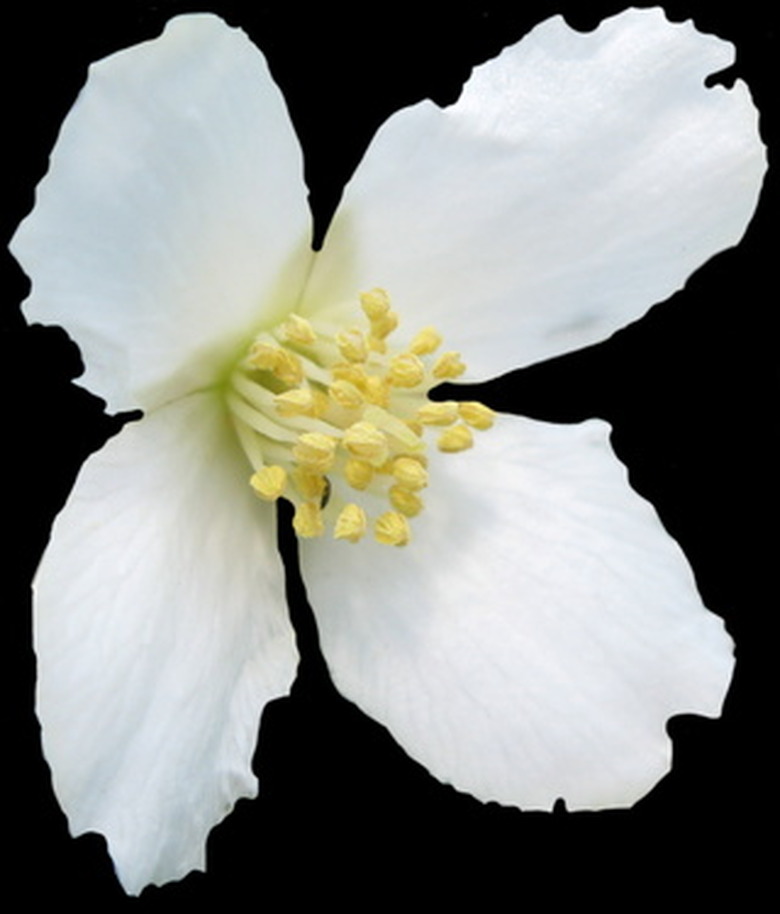Mock Orange Leaf Identification
The mock orange (Philadelphus species) is a group of 50 or so tall, hardy shrubs, several of which are native to the United States. Popular because of their simple white flowers and sometimes sweet scent, they were widely hybridized from the early to mid 20th century for use as ornamental shrubs in the garden; over-breeding led to many varieties of scentless flowers. A West Coast species of mock orange, Philadelphus lewisii, was first collected by Meriwether Lewis in 1806 during his and William Clark's joint expedition to the mouth of the Columbia River.
About Mock Orange
Members of the mock orange species are deciduous flowering shrubs native to every state excepting those in the central Great Plains. Once established, shrubs rapidly attain a mature height of between 8 and 15 feet, spreading from 8 to 10 feet wide. White, four-petaled flowers appear on most species from late spring to early summer; some are highly fragrant, while others lack any scent at all.
Mock Orange Leaf Identification
Leaves on most species of mock oranges closely resemble each other. Leaves grow oppositely, that is, in pairs directly adjacent to one another on the stem. Leaf color ranges from medium green to dark green, and the undersides are usually pale green to white. Leaves on a single bush vary in size from 1 inch to 4 inches long. In shape, leaves are rounded at the base with small, erratically spaced serrations along the edges; leaves grow to a point so the entire effect is that of a pointed oval. On some species, leaves are slightly fuzzy above and below. Fall color is an inconspicuous yellow.
- The mock orange (Philadelphus species) is a group of 50 or so tall, hardy shrubs, several of which are native to the United States.
- White, four-petaled flowers appear on most species from late spring to early summer; some are highly fragrant, while others lack any scent at all.
Plant Care and Culture
While mock oranges can tolerate moderately dry soils, most members of this shrub group grow best in moist, well-drained, humus-rich soils. In wild habitats, the mock orange is found growing in both sunny and partly shady conditions. Most species are hardy to USDA Zone 5, though several are hardy to Zone 4.
Pests and Diseases
Mock oranges are generally untroubled by pest or insect. Occasionally a canker occurs, caused by the plant pathogen Nectria cinnabarina, which forms as a reddish to whitish lump on the stem that slowly kills the plant stems. Stems must be pruned off the shrub, as the infection has no known chemical remedy. During rainy periods, leaf spot may occur, as can powdery mildew; affected leaves should be pruned off and destroyed.
- While mock oranges can tolerate moderately dry soils, most members of this shrub group grow best in moist, well-drained, humus-rich soils.
- During rainy periods, leaf spot may occur, as can powdery mildew; affected leaves should be pruned off and destroyed.
Uses in the Garden
At least during the growing season, the dense, shrubby growth habit of the mock orange makes it an excellent candidate for a screen hedge. Older growth can be pruned back to allow for better light and airflow through the middle of the shrub. After the mock orange's flowering period, the foliage alone is rather unremarkable; the shrub's leggy growth habit makes it unsuitable as a specimen plant. Mock orange is best planted along disused borders, along fencelines or as part of a naturalized setting under larger trees.
